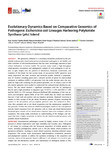2021-03-02Zeitschriftenartikel
Evolutionary Dynamics Based on Comparative Genomics of Pathogenic Escherichia coli Lineages Harboring Polyketide Synthase (pks) Island
Suresh, Arya
Shaik, Sabiha
Baddam, Ramani
Ranjan, Amit
Qumar, Shamsul
Jadhav, Savita
Semmler, Torsten
Ghazi, Irfan A.
Wieler, Lothar H.
Ahmed, Niyaz
The genotoxin colibactin is a secondary metabolite produced by the polyketide synthase (pks) island harbored by extraintestinal pathogenic E. coli (ExPEC) and other members of the Enterobacteriaceae that has been increasingly reported to have critical implications in human health. The present study entails a high-throughput whole-genome comparison and phylogenetic analysis of such pathogenic E. coli isolates to gain insights into the patterns of distribution, horizontal transmission, and evolution of the island. For the current study, 23 pks-positive ExPEC genomes were newly sequenced, and their virulome and resistome profiles indicated a preponderance of virulence encoding genes and a reduced number of genes for antimicrobial resistance. In addition, 4,090 E. coli genomes from the public domain were also analyzed for large-scale screening for pks-positive genomes, out of which a total of 530 pks-positive genomes were studied to understand the subtype-based distribution pattern(s). The pks island showed a significant association with the B2 phylogroup (82.2%) and a high prevalence in sequence type 73 (ST73; n = 179) and ST95 (n = 110) and the O6:H1 (n = 110) serotype. Maximum-likelihood (ML) phylogeny of the core genome and intergenic regions (IGRs) of the ST95 model data set, which was selected because it had both pks-positive and pks-negative genomes, displayed clustering in relation to their carriage of the pks island. Prevalence patterns of genes encoding RM systems in the pks-positive and pks-negative genomes were also analyzed to determine their potential role in pks island acquisition and the maintenance capability of the genomes. Further, the maximum-likelihood phylogeny based on the core genome and pks island sequences from 247 genomes with an intact pks island demonstrated horizontal gene transfer of the island across sequence types and serotypes, with few exceptions. This study vitally contributes to understanding of the lineages and subtypes that have a higher propensity to harbor the pks island-encoded genotoxin with possible clinical implications.
IMPORTANCE Extraintestinal pathologies caused by highly virulent strains of E. coli amount to clinical implications with high morbidity and mortality rates. Pathogenic E. coli strains are evolving with the horizontal acquisition of mobile genetic elements, including pathogenicity islands such as the pks island, which produces the genotoxin colibactin, resulting in severe clinical outcomes, including colorectal cancer progression. The current study encompasses high-throughput comparative genomics and phylogenetic analyses to address the questions pertaining to the acquisition and evolution pattern of the genomic island in different E. coli subtypes. It is crucial to gain insights into the distribution, transfer, and maintenance of pathogenic islands, as they harbor multiple virulence genes involved in pathogenesis and clinical implications of the infection.

